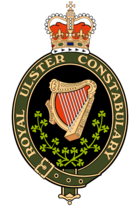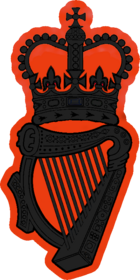
Back Royal Ulster Constabulary Catalan Královská ulsterská policie Czech Cwnstabliaeth Frenhinol Ulster Welsh Royal Ulster Constabulary Danish Royal Ulster Constabulary German Βασιλική Χωροφυλακή του Όλστερ Greek Royal Ulster Constabulary Spanish Kuninglik Ulsteri Politseijõud Estonian Royal Ulster Constabulary Basque Police royale de l'Ulster French
This article needs additional citations for verification. (July 2014) |
| Royal Ulster Constabulary | |
|---|---|
 Badge of the RUC | |
 Cap Badge of the RUC from 1970 onwards. | |
 Flag of the RUC | |
| Abbreviation | RUC |
| Agency overview | |
| Formed | 1 June 1922 |
| Preceding agency | |
| Dissolved | 4 November 2001 |
| Superseding agency | Police Service of Northern Ireland |
| Legal personality | Police force |
| Jurisdictional structure | |
| National agency | Northern Ireland |
| Operations jurisdiction | Northern Ireland |
 | |
| Map of Royal Ulster Constabulary's jurisdiction | |
| Size | 14,130 km2 (5,460 sq mi)[1] |
| General nature | |
The Royal Ulster Constabulary (RUC)[n 1] was the police force in Northern Ireland from 1922 to 2001. It was founded on 1 June 1922 as a successor to the Royal Irish Constabulary (RIC)[2] following the partition of Ireland. At its peak the force had around 8,500 officers, with a further 4,500 who were members of the RUC Reserve.
The RUC policed Northern Ireland from the aftermath of the Irish War of Independence until after the turn of the 21st century and played a major role in the Troubles between the 1960s and the 1990s. Due to the threat from the Provisional Irish Republican Army (IRA), who saw the RUC as enforcing British rule, the force was heavily armed and militarised. Officers routinely carried submachine guns and assault rifles, travelled in armoured vehicles, and were based in heavily fortified police stations.[3] It was the first police force to use rubber and plastic bullets for riot control.
The RUC's membership was overwhelmingly Protestant, leading to accusations by sections of the Catholic and Irish nationalist minority of one-sided policing and sectarianism. Officers were also accused of police brutality as well as collusion with loyalist paramilitaries.[4][5] Conversely, it was praised as one of the most professional police forces in the world by British security forces.[6] During the Troubles, 319 RUC officers were killed and almost 9,000 injured in paramilitary assassinations or attacks, mostly by the IRA, which made the RUC the most dangerous police force in the world in which to serve by 1983.[7][8][9] In the same period, the RUC killed 55 people, 28 of whom were civilians.[10] In 2000, the RUC was awarded the George Cross for bravery.
The RUC was superseded by the Police Service of Northern Ireland (PSNI) in 2001, as mandated by the final version of the Police (Northern Ireland) Act 2000.[11] Allegations regarding collusion prompted several inquiries, the most recent of which was authored by Police Ombudsman Nuala O'Loan in 2007. The report identified police, CID and Special Branch collusion with loyalist terrorists, but no member of the RUC has been charged or convicted of any criminal acts as a result of these inquiries. O'Loan stated in her conclusions that there was no reason to believe the findings of the investigation were isolated incidents.[12]
- ^ ONS Geography (8 January 2016). "The Countries of the UK". Office for National Statistics. Office for National Statistics (United Kingdom). Archived from the original on 1 January 2016. Retrieved 26 November 2021.
{{cite web}}: CS1 maint: bot: original URL status unknown (link) - ^ Richard Doherty, The Thin Green Line – The History of the Royal Ulster Constabulary GC, pp. 5, 17, 27, 93, 134, 271; Pen & Sword Books; ISBN 1-84415-058-5
- ^ Weitzer, Ronald. Policing Under Fire: Ethnic Conflict and Police-Community Relations in Northern Ireland. SUNY Press, 1995. pp.72-73
- ^ [1] Archived 26 August 2016 at the Wayback Machine, 15 murders linked to police collusion with loyalists.
- ^ [2] Archived 2 October 2018 at the Wayback Machine, There was collusion between some police officers and loyalist gunmen who killed six Catholics 22 years ago, a report by NI's Police Ombudsman has said.
- ^ "The RUC: Lauded and condemned". BBC News. bbc.co.uk. 31 October 2001. Archived from the original on 29 August 2017. Retrieved 5 June 2007.
Condemned by republicans, nationalists and human rights groups for embodying sectarianism and lauded by British security forces as one of the most professional police operations in the world, the Royal Ulster Constabulary is one of the most controversial police forces in the UK.
- ^ Number of RUC killed during the Troubles Archived 19 July 2006 at the Wayback Machine, cain.ulst.ac.uk; accessed 22 December 2014.
- ^ "CNN Specials - Northern Ireland". 29 August 2007. Archived from the original on 29 August 2007.
In 1983, Interpol figures showed that Northern Ireland was the most dangerous place in the world to be a police officer, the risk factor being twice as high as in El Salvador, the second most dangerous.
- ^ "Northern Ireland – Identity Crisis for Police". CNN. Archived from the original on 29 August 2007.
- ^ Number of people killed by RUC in Northern Ireland Archived 7 September 2015 at the Wayback Machine, cain.ulst.ac.uk; accessed 22 December 2014.
- ^ Russell, Deacon (2012). Devolution in the United Kingdom. Edinburgh University Press. p. 218. ISBN 978-0748669738.
- ^ Synopsis of report by Ombudsman Nuala O'Loan Archived 19 September 2007 at the Wayback Machine, BBC.co.uk; accessed 19 September 2014.
Cite error: There are <ref group=n> tags on this page, but the references will not show without a {{reflist|group=n}} template (see the help page).
© MMXXIII Rich X Search. We shall prevail. All rights reserved. Rich X Search